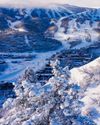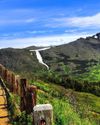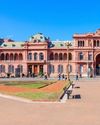Despite the oil slowdown, Houston booms with development and economic growth.

In 1836, shortly after the Battle of San Jacinto gave birth to the Republic of Texas, two entrepreneurial brothers, Augustus and John Allen, advertised the 8,850 acres they purchased in an alligator- and mosquito-infested prairie swamp not far from the Gulf of Mexico. They claimed the land was well-developed, with steamboats running in Buffalo Bayou and houses on Alpine-like hills. In reality the land had no roads or river boats, no structures and certainly no mountains. They named their city after Sam Houston, the hero of the recent battle who would be elected president of the new republic, and by the end of 1836, Houston — capital of Texas for a few years — became the major cotton-trading center for the area’s slave plantations.
In 1901 the Spindletop oil well erupted, and the busy railroad and shipping town of 44,000 residents became the energy capital of the world, bringing wealth, unbridled expansion and a can-do attitude. Today Houston is the country’s fourth-most populated city (2.2 million residents) and fifth-biggest metro area (6.4 million), encompassing 655 square miles.
Large-scale development — including massive suburbs with their own downtowns — continues in the Houston-Woodlands-Sugarland metro area despite the oil and gas slowdown. Average house sale prices increase in the neighborhoods of Montrose, River Oaks, Memorial Villages and Rice/Museum District even as bankruptcies and layoffs occur among the 500 energy-related companies in the area.
Bu hikaye Global Traveler dergisinin September 2016 sayısından alınmıştır.
Start your 7-day Magzter GOLD free trial to access thousands of curated premium stories, and 9,000+ magazines and newspapers.
Already a subscriber ? Giriş Yap
Bu hikaye Global Traveler dergisinin September 2016 sayısından alınmıştır.
Start your 7-day Magzter GOLD free trial to access thousands of curated premium stories, and 9,000+ magazines and newspapers.
Already a subscriber? Giriş Yap

Nurturing Nature
Connect with the abundant flora and fauna of Belize.

Sojourn by the Sea
Discover plenty to smile about in Thailand’s exotic islands.

Colorado Dreaming
For family ski fun, Snowmass and Beaver Creek steal the show.

The Great Outdoors
Anchorage opens the door to all that is wild in Alaska.

Buenos Aires on Foot
Hit the highlights with online itineraries and the city’s free app.

Above and Beyond
Global Traveler celebrates the 2021 winners of the GT Tested Reader Survey awards.

Wellness Wonderland
Reboot at Lake Austin Spa Resort in Texas Hill Country.

Good Vibes
Adelaide’s West End thrives as a hip urban hub close to nature.

Solo Voyages
Cruise lines adapt policies to accommodate those traveling alone.

Grand Slam
Follow the pro tennis tour around the world.